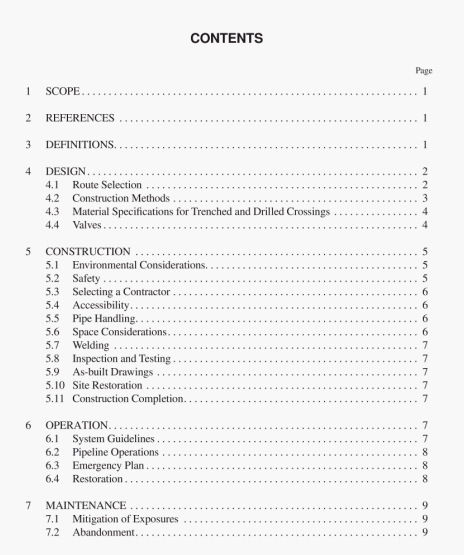API RP 1133:2005 pdf download.Guidelines for Onshore Hydrocarbon Pipelines Affecting High Consequence Floodplains.
4.1.2 Buried Crossings
In locating the route vertically, the potential for future degradaion or scour of the channel should be considered by reviewing the hydrology of the channel, conducting a geotechnical insestigation. as well as reviewing site records and existing topographic maps. The pipeline should be placed at a depth below the expected level of scour. Minimum burial depth of trenched crossings shall comply with U.S. Army Corps of Engineers. [)epartment of Transportation 130T, Office of Pipeline Safety. and other applicable regulatory requirements.
The lateral location of the pipeline should be determined after a carelul review of channel hydrology. The lateral stability of the channel should be determined. Characteristics of channel instability include the following:
• Bank erosion.
• Migration of the channel within the floodplain, and
• Migration of meanders downstream.
The rate of hank erosion and migration can be projected by reviewing the hydrology and ftrecasting the changes in the channel for the design life of the pipeline. The Lateral location of the pipeline and elTixtive length of the crossing arc then determined based on these projections. Adequate depth should be maintained to eliminate impacts from the future migration of the channel. For example. if the migration rate is 2 ft per year and hc design lik is 50 years. the depth below the level of scour should be maintained for at least 100 ft from the bank in the direction of channel migration. Special consideration should he given to previously existing channels that may scour as a result of secondary overhank flows during flood conditions.
Significant savings can be realized if several pipelines an bundled together in one crossing. Directionally-drilled crossings may be bundled if the diarneer of the bundled pipelines does not exceed the largest diameter bore that can be installed. One or more spare pipelines within the bundle may be considered to allow for future expansion. For pipelines that are bundIed together, provisions should be made for adequate corrosion control to prevent interference of cathodic syswms or to present one or more lines from acting as a sacrifIcial anode.
The adequacy of the host bridge to support the addi-
tional weight of the pipeline and its appurtenant sup-port system,
-The design of the pipeline support system itself, and. The location of the pipeline on the host bridge so as to
protect it from outside force damage.
Installation on a host bridge requires compliance with thehost bridge owner’s standards and design practices. The hostbridge should be structurally analyzed to ensure the bridge isnot overstressed as a result of the weight of the pipeline andits contents.
– A dedicated bridge may be designed specifically for a
pipeline crossing.Several different bridge designs aresuitable for a pipeline crossing of a water course,including suspension,prefabricated steel,reinforcedconcrete, and self-spanning pipe.
Aerial crossings should be designed by a qualified engineerexperienced in bridge design.
API RP 1133:2005 pdf download
